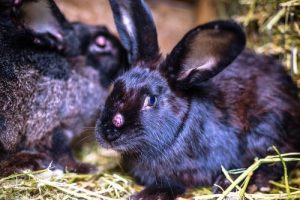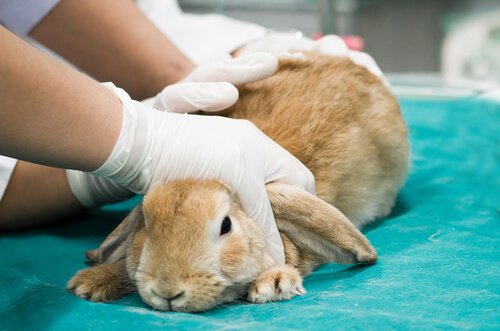Viral Diseases in Rabbits and How They Affect Other Animals


Written and verified by the vet Eugenio Fernández Suárez
Rabbits are considered to be exotic pets and are becoming more common as house pets. However, they can carry several viruses that cause dangerous diseases for both pets and wild animals.
Even though viruses are not so common in domestic rabbits, they are still able to contract them. Viruses are especially problematic for rabbit breeders, and can even affect other wild species and their ability to survive.
What is Myxomatosis?
Probably one of the most well-known viruses that rabbits contract is myxomatosis. It’s a highly contagious disease that affects domestic pets and wild rabbits. The cause is a Poxviridae family virus and it’s very similar to the virus that causes smallpox.
Myxomatosis spreads through direct contact with sick animals, or through blood-feeding insects like mosquitoes. These bugs act as carriers and they spread the disease to ill and healthy people. That’s why these dieases are usually related to an increase in insect populations and are more common in humid areas during the hot season.
Having contact with items contaminated with secretions and exudates from sick rabbits (both nasal and ocular) can also be a source of contamination.

As far as symptoms are concerned, they will depend on the viral strain, there will either be larger or smaller amounts of myxomas or lumps on the animal’s face and genitals. They even appear on mucous membranes, and these tend to spread throughout the body.
Myxomatosis has a high mortality in adult animals. However, babies that are less than a month old often fight off the infection. The incubation period is between three and six days, and there still is not an effective treatment for this disease.
What is Viral Hemorrhagic Disease?
This is another disease that rabbits can carry. It is very contagious and has a high mortality rate. Viral hemorrhagic disease is caused by a calicivirus transmitted through direct contact with sick animals or contaminated objects. This includes water troughs, clothes, and cages.
The disease has a short incubation period that lasts between one and three days. The symptoms usually appear in rabbits that are over two months old by causing them to have sudden fevers and death within 12 to 36 hours. A viral hemorrhagic disease causes symptoms such as diarrhea, swelling, weight loss, and respiratory/nervous signs.
Even though it’s not an easily observable symptom, this virus causes hemorrhaging in several organs, which its name indicates.

Both types of viruses can and need to be prevented by getting your pet rabbit properly vaccinated. However, you should talk to a trusted veterinarian about when to apply them.
Even though it’s not common for domestic rabbits to contract these viruses, keeping your rabbit’s vaccinations current is highly recommended and will help protect your pet.
Both myxomatosis and hemorrhagic viral disease have to be diagnosed by first identifying the virus. Dozens of rabbits have died after showing these viral symptoms. However, these animals can survive if their owners are able to recognize the symptoms on time.
The Impact of Viruses Transmitted by Rabbits
Both diseases were used against rabbits in Australia, which caused millions of them to die. A similar thing happened in several European countries, such as Great Britain and Germany. Rabbits were quickly growing in number due to lack of predators, so these countries infected them with myxomatosis to kill them. This was Armand Delille’s idea, a French doctor who introduced myxomatosis in Europe around the 1950’s.
There was no intention of reducing the rabbit population in other countries. Unfortunately, Myxomatosis poses a danger to wild rabbits and the animals that depend on them. The appearance of these diseases in Spain has caused a drop in number of several species such as the Imperial Eagle and the Iberian Lynx, which is currently in danger of extinction.
Rabbits are considered to be exotic pets and are becoming more common as house pets. However, they can carry several viruses that cause dangerous diseases for both pets and wild animals.
Even though viruses are not so common in domestic rabbits, they are still able to contract them. Viruses are especially problematic for rabbit breeders, and can even affect other wild species and their ability to survive.
What is Myxomatosis?
Probably one of the most well-known viruses that rabbits contract is myxomatosis. It’s a highly contagious disease that affects domestic pets and wild rabbits. The cause is a Poxviridae family virus and it’s very similar to the virus that causes smallpox.
Myxomatosis spreads through direct contact with sick animals, or through blood-feeding insects like mosquitoes. These bugs act as carriers and they spread the disease to ill and healthy people. That’s why these dieases are usually related to an increase in insect populations and are more common in humid areas during the hot season.
Having contact with items contaminated with secretions and exudates from sick rabbits (both nasal and ocular) can also be a source of contamination.

As far as symptoms are concerned, they will depend on the viral strain, there will either be larger or smaller amounts of myxomas or lumps on the animal’s face and genitals. They even appear on mucous membranes, and these tend to spread throughout the body.
Myxomatosis has a high mortality in adult animals. However, babies that are less than a month old often fight off the infection. The incubation period is between three and six days, and there still is not an effective treatment for this disease.
What is Viral Hemorrhagic Disease?
This is another disease that rabbits can carry. It is very contagious and has a high mortality rate. Viral hemorrhagic disease is caused by a calicivirus transmitted through direct contact with sick animals or contaminated objects. This includes water troughs, clothes, and cages.
The disease has a short incubation period that lasts between one and three days. The symptoms usually appear in rabbits that are over two months old by causing them to have sudden fevers and death within 12 to 36 hours. A viral hemorrhagic disease causes symptoms such as diarrhea, swelling, weight loss, and respiratory/nervous signs.
Even though it’s not an easily observable symptom, this virus causes hemorrhaging in several organs, which its name indicates.

Both types of viruses can and need to be prevented by getting your pet rabbit properly vaccinated. However, you should talk to a trusted veterinarian about when to apply them.
Even though it’s not common for domestic rabbits to contract these viruses, keeping your rabbit’s vaccinations current is highly recommended and will help protect your pet.
Both myxomatosis and hemorrhagic viral disease have to be diagnosed by first identifying the virus. Dozens of rabbits have died after showing these viral symptoms. However, these animals can survive if their owners are able to recognize the symptoms on time.
The Impact of Viruses Transmitted by Rabbits
Both diseases were used against rabbits in Australia, which caused millions of them to die. A similar thing happened in several European countries, such as Great Britain and Germany. Rabbits were quickly growing in number due to lack of predators, so these countries infected them with myxomatosis to kill them. This was Armand Delille’s idea, a French doctor who introduced myxomatosis in Europe around the 1950’s.
There was no intention of reducing the rabbit population in other countries. Unfortunately, Myxomatosis poses a danger to wild rabbits and the animals that depend on them. The appearance of these diseases in Spain has caused a drop in number of several species such as the Imperial Eagle and the Iberian Lynx, which is currently in danger of extinction.
This text is provided for informational purposes only and does not replace consultation with a professional. If in doubt, consult your specialist.








